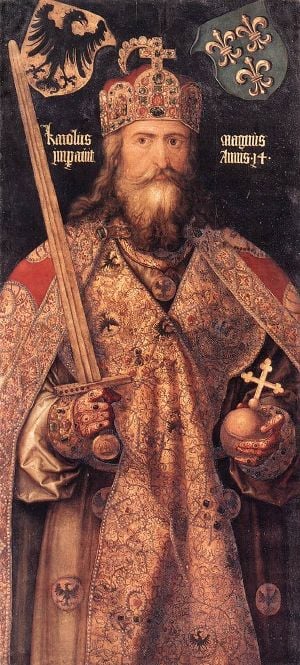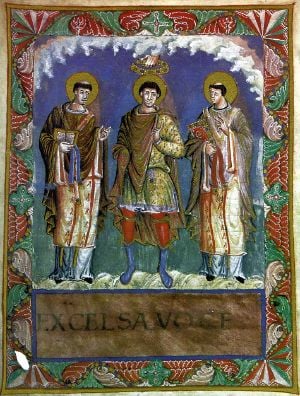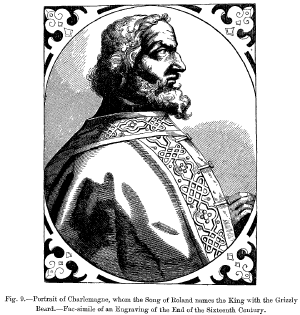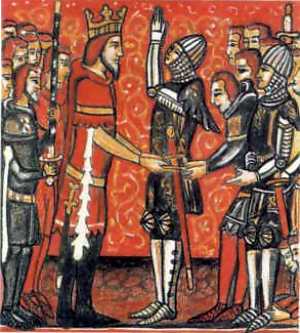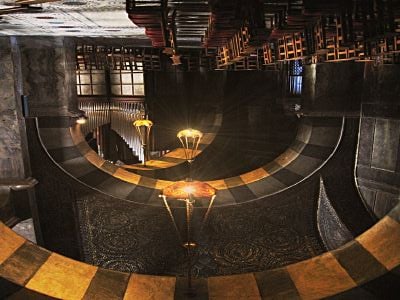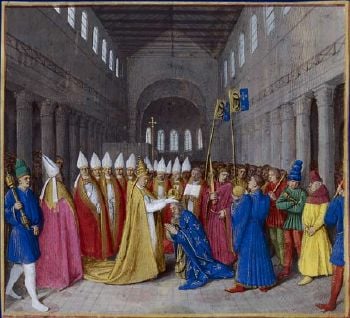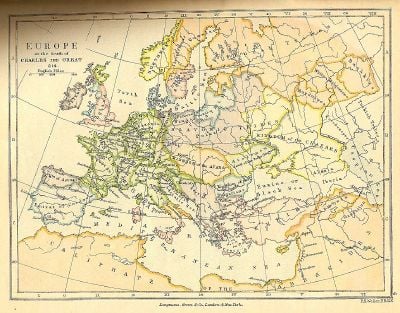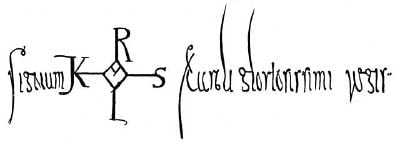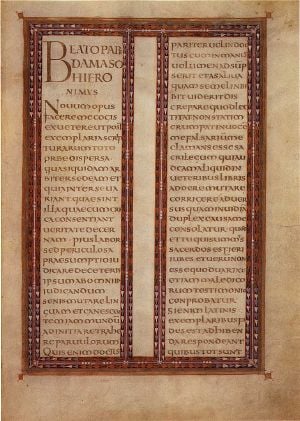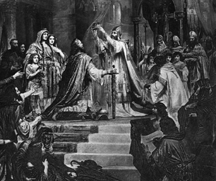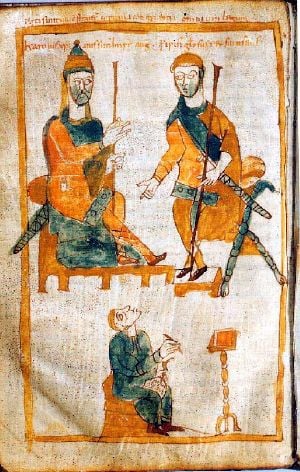Charlemagne
Charlemagne (742 or 747 – January 28, 814) (also Charles the Great; [1] from Latin, Carolus Magnus or Karolus Magnus), son of King Pippin the Short and Bertrada of Laon, was the king of the Franks from 768 C.E. to 814 C.E. and king of the Lombards from 774 C.E. to 814 C.E.
Charlemagne was crowned Imperator Augustus in Rome on Christmas Day, 800 by Pope Leo III and is therefore regarded as the founder of the Holy Roman Empire (as Charles I). Through military conquest and defense, he solidified and expanded his realm to cover most of Western Europe. He is often seen as the Father of Europe and is an iconic figure, instrumental in defining European identity. His was the first truly imperial power in the West since the fall of Rome.
Background
The Franks, originally a pagan, barbarian, Germanic people who migrated over the River Rhine in the late fifth century into a crumbling Roman Empire, were, by the early eighth century, the masters of Gaul and a good portion of central Europe east of the Rhine and the protectors of the Papacy and the Catholic faith. However, their ancient dynasty of kings, the Merovingians, had long before declined into a state of uselessness. Practically all government powers of any consequence were exercised by their chief officers, the Mayors of the Palace or majordomos. The final dynasts were called rois fainéants, do-nothing kings, and were hardly noticed. For a period of five years (737-742 C.E.), Mayor Charles Martel governed the Franks with no one on the throne.
These mayors of the palace took over the Frankish empire and became more active monarchs. Mayor Charles Martel was the illegitimate son of the Mayor Pippin of Heristal, who himself was the son of a Mayor Ansegisel and his wife, Saint Begga. It is through the fathers of Ansegisel and Begga, Saint Arnulf of Metz, and Pippin of Landen, respectively, that Martel's dynasty received its name, that of Arnulfings or Pippinids. Martel died before he could place a new puppet king on the throne and he was succeeded by his son Pippin the Short, the father of Charlemagne. Pippin promptly placed a puppet on the throne and refusing to play any part in such a charade as his father's; he called for the pope, Pope Zachary, to give the man with the royal power the royal title. This the pope did and Pippin was crowned and consecrated king of the Franks in 751 C.E.
As a consequence of this, Pippin's eldest son, Charlemagne, immediately became heir to the great realm which already covered most of western and central Europe. It was not the old name of Pippin of Landen or Ansegisel that was to be immortalized, however. Called the Carolingian Dynasty from his Latin name, Carolus, the new dynasty spread to encompass an area including most of Western Europe and, through various treaties and divisions of property, laid the groundwork for the French and German states.[2][3]
Date and place of birth
Charlemagne's birthday was believed to be April 2, 742; however several factors led to reconsideration of this traditional date. First, the year 742 was calculated from his age given at death, rather than attestation within primary sources. Another date is given in the Annales Petarienses, April 1, 747C.E. In that year, April 1 is Easter. The birth of an Emperor on Easter is a coincidence likely to provoke comment, but there is no such comment documented in 747 C.E., leading some to suspect that the Easter birthday was a pious fiction concocted as a way of honoring the Emperor. Other commentators weighing the primary records have suggested that the birth was one year later, 748 C.E. At present, it is impossible to be certain of the date of the birth of Charlemagne. The best guesses include April 1, 747 C.E., after April 15, 747 C.E., or April 1, 748 C.E., probably in Herstal or Jupille (where his father was born), both close to Liège, in Belgium, the region from which both the Meroving and Caroling families originate. Other cities have been suggested, including Prüm, Düren, or Aachen.
Personal appearance
Charlemagne's personal appearance is not known from any contemporary portrait, but it is known rather famously from a good description by Einhard, author of the biographical Vita Caroli Magni. He is well known to have been tall, stately, and fair-haired, with disproportionately thick neck. His skeleton was measured during the eighteenth century and his height was determined to be 1.90 m (6 ft 3 in), and as Einhard tells it in his twenty-second chapter:
Charles was large and strong, and of lofty stature, though not disproportionately tall (his height is well known to have been seven times the length of his foot); the upper part of his head was round, his eyes very large and animated, nose a little long, hair fair, and face laughing and merry. Thus his appearance was always stately and dignified, whether he was standing or sitting; although his neck was thick and somewhat short, and his belly rather prominent; but the symmetry of the rest of his body concealed these defects. His gait was firm, his whole carriage manly, and his voice clear, but not so strong as his size led one to expect.[4]
The Roman tradition of realistic personal portraiture was in complete eclipse at this time, where individual traits were submerged in iconic type castings. Charlemagne, as an ideal ruler, ought to be portrayed in the corresponding fashion, any contemporary would have assumed. The images of enthroned Charlemagne, God's representative on Earth, bear more connections to the icons of Christ in majesty than to modern (or antique) conceptions of portraiture. Charlemagne in later imagery (as in the Dürer portrait) is often portrayed with flowing blond hair, due to a misunderstanding of Einhard, who describes Charlemagne as having canitie pulchra, or "beautiful white hair," which has been rendered as blond or fair in many translations. The Latin word for blond is flavus. Charlemagne wore the traditional, inconspicuous, and distinctly non-aristocratic costume of the Frankish people. He always carried a sword. On ceremonial occasions, he he wore embroidery and jewels on his clothing and shoes. He had a golden buckle for his cloak on such occasions and would appear with his great diadem, but he despised such apparel, according to Einhard, and usually dressed as did the common people.
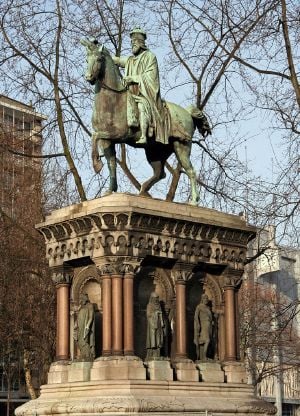
Life
Much of what is known of Charlemagne's life comes from his biographer, Einhard.
Early life
Charlemagne was the eldest child of Pippin the Short (714 C.E. – 24 September 768 C.E., reigned from 751 C.E.) and his wife Bertrada of Laon (720 C.E. – 12 July 783 C.E.), daughter of Caribert of Laon and Bertrada of Cologne. The reliable records name only Carloman, son of Pippin III and Gisela as his younger siblings. Later accounts, however, indicate that Redburga, wife of King Egbert of Wessex, might have been his sister (or sister-in-law or niece), and the legendary material makes him Roland's maternal nephew through Lady Bertha.
Einhard says of the early life of Charles:
It would be folly, I think, to write a word concerning Charles' birth and infancy, or even his boyhood, for nothing has ever been written on the subject, and there is no one alive now who can give information on it. Accordingly, I determined to pass that by as unknown, and to proceed at once to treat of his character, his deed, and such other facts of his life as are worth telling and setting forth, and shall first give an account of his deed at home and abroad, then of his character and pursuits, and lastly of his administration and death, omitting nothing worth knowing or necessary to know.[5]
This article follows that general format.
On the death of Pippin, the kingdom of the Franks was divided—following tradition—between Charlemagne and Carloman. Charles took the outer parts of the kingdom, bordering on the sea, namely Neustria, western Aquitaine, and the northern parts of Austrasia, while Carloman retained the inner parts: southern Austrasia, Septimania, eastern Aquitaine, Burgundy, Provence, and Swabia, lands bordering on Italy. Perhaps Pippin regarded Charlemagne as the better warrior, but Carloman may have regarded himself as the more deserving son, being the son, not of a mayor of the palace, but of a king.
Joint rule
On October 9, immediately after the funeral of their father, both the kings withdrew from Saint Denis to be proclaimed by their nobles and consecrated by their bishops, Charlemagne in Noyon and Carloman in Soissons.
The first event of his reign was the rising of the Aquitainians and Gascons, in 769 C.E., in that territory split between the two kings. Pippin had killed in war the last duke of Aquitaine, Waifer. Now, one Hunold—perhaps the same Hunold who was father to Waifer, but perhaps someone else—led the Aquitainians as far north as Angoulême. Charlemagne met Carloman, but Carloman refused to participate and returned to Burgundy. Charlemagne went on the warpath, leading an army to Bordeaux, where he set up a camp at Fronsac. Hunold was forced to flee to the court of Duke Lupus II of Gascony. Lupus, fearing Charlemagne, turned Hunold over in exchange for peace. He was put in a monastery. Aquitaine was finally fully subdued by the Franks.
The brothers maintained lukewarm relations with the assistance of their mother Bertrada, but Charlemagne signed a treaty with Duke Tassilo III of Bavaria and married Gerperga, daughter of King Desiderius of the Lombards, in order to surround Carloman with his own allies. Though Pope Stephen III first opposed the marriage with the Lombard princess, he would have little to fear of a Frankish-Lombard alliance in a few months.
Charlemagne repudiated his wife and quickly married another, a Swabian named Hildegard of Savoy. The repudiated Gerperga returned to her father's court at Pavia. The Lombard's wrath was now aroused and he would gladly have allied with Carloman to defeat Charles. But before war could break out, Carloman died on December 5, 771 C.E. Carloman's wife Gerberga (often confused by contemporary historians with Charlemagne's former wife, who probably shared her name) fled to Desiderius' court with her sons for protection. This action is usually considered either a sign of Charlemagne's enmity or Gerberga's confusion.
Conquest of Lombardy
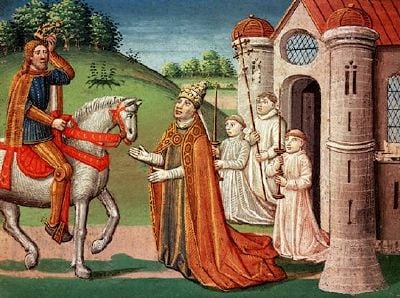
At the succession of Pope Hadrian I in 772 C.E., he demanded the return of certain cities in the former exarchate of Ravenna as in accordance with a promise of Desiderius' succession. Desiderius instead took over certain papal cities and invaded the Pentapolis, heading for Rome. Hadrian sent embassies to Charlemagne in autumn requesting he enforce the policies of his father, Pippin. Desiderius sent his own embassies denying the pope's charges. The embassies both met at Thionville and Charlemagne upheld the pope's side. Charlemagne promptly demanded what the pope had demanded and Desiderius promptly swore never to comply. The invasion was not short in coming. Charlemagne and his uncle Bernhard, son of Charles Martel crossed the Alps in 773 C.E. and chased the Lombards back to Pavia, which they then besieged. Charlemagne temporarily left the siege to deal with Adelchis, son of Desiderius, who was raising an army at Verona. The young prince was chased to the Adriatic littoral and he fled to Constantinople to plead for assistance from Constantine V Copronymus, who was waging war with the Bulgars.
The siege lasted until the spring of 774 C.E., when Charlemagne visited the pope in Rome. There he confirmed his father's grants of land, with some later chronicles claiming—falsely—that he also expanded them, granting Tuscany, Emilia, Venice, and Corsica. The pope granted him the title patrician. He then returned to Pavia, where the Lombards were on the verge of surrendering.
In return for their lives, the Lombards surrendered and opened the gates in early summer. Desiderius was sent to the abbey of Corbie and his son Adelchis died in Constantinople a patrician. Charles, unusually, had himself crowned with the Iron Crown of Lombardy and made the magnates of Lombardy do homage to him at Pavia. Only Duke Arechis II of Benevento refused to submit and proclaimed independence. Charlemagne was now master of Italy as king of the Lombards. He left Italy with a garrison in Pavia and few Frankish counts in place that very year.
There was still instability, however, in Italy. In 776 C.E., Dukes Hrodgaud of Friuli and Gisulf of Spoleto rebelled. Charlemagne whisked back from Saxony and defeated the duke of Friuli in battle. The duke was slain. The duke of Spoleto signed a treaty. Their co-conspirator, Arechis, was not subdued and Adelchis, their candidate in Byzantium, never left that city. Northern Italy was now faithfully his.
Saxon campaigns
Charlemagne was engaged in almost constant battle throughout his reign, with his legendary sword "Joyeuse" in hand. After 30 years of war and 18 battles—the Saxon Wars—he conquered Saxonia and proceeded to convert the conquered to Roman Catholicism, using force where necessary.
The Saxons were divided into four subgroups in four regions. Nearest to Austrasia was Westphalia and furthest away was Eastphalia. In between these two kingdoms was that of Engria and north of these three, at the base of the Jutland peninsula, was Nordalbingia.
In his first campaign, Charlemagne forced the Engrians in 773 C.E. to submit and cut down the pagan holy tree "Irminsul" near Paderborn. The campaign was cut short by his first expedition to Italy. He returned in the year 775 C.E., marching through Westphalia and conquering the Saxon fort of Sigiburg. He then crossed Engria, where he defeated the Saxons again. Finally, in Eastphalia, he defeated a Saxon force, and its leader Hessi converted to Christianity. He returned through Westphalia, leaving encampments at Sigiburg and Eresburg, which had, up until then, been important Saxon bastions. All Saxony but Nordalbingia was under his control, but Saxon resistance had not ended.
Following his campaign in Italy subjugating the dukes of Friuli and Spoleto, Charlemagne returned very rapidly to Saxony in 776 C.E., where a rebellion had destroyed his fortress at Eresburg. The Saxons were once again brought to heel, but their main leader, duke Widukind, managed to escape to Denmark, home of his wife. Charlemagne built a new camp at Karlstadt. In 777 C.E., he called a national diet (assembly) at Paderborn to integrate Saxony fully into the Frankish kingdom. Many Saxons were baptized.
In the summer of 779 C.E., he again invaded Saxony and reconquered Eastphalia, Engria, and Westphalia. At a diet near Lippe, he divided the land into missionary districts and himself assisted in several mass baptisms (780). He then returned to Italy and, for the first time, there was no immediate Saxon revolt. From 780 to 782 C.E., the land had peace.
He returned in 782 C.E. to Saxony and instituted a code of law and appointed counts, both Saxon and Frank. The laws were draconian on religious issues, and the native traditional religion was gravely threatened. This stirred a renewal of the old conflict. That year, in autumn, Widukind returned and led a new revolt, which resulted in several assaults on the church. In response, at Verden in Lower Saxony, Charlemagne allegedly ordered the beheading of 4,500 Saxons who had been caught practicing paganism after converting to Christianity, known as the Bloody Verdict of Verden or Massacre of Verden. The massacre, which modern research has not been able to confirm, triggered two years of renewed bloody warfare (783-785 C.E.). During this war the Frisians were also finally subdued and a large part of their fleet was burned. The war ended with Widukind accepting baptism.
Thereafter, the Saxons maintained the peace for seven years, but in 792 C.E. the Westphalians once again rose against their conquerors. The Eastphalians and Nordalbingians joined them in 793 C.E., but the insurrection did not catch on and was put down by 794 C.E. An Engrian rebellion followed in 796 C.E., but Charlemagne's personal presence and the presence of loyal Christian Saxons and Slavs quickly crushed it. The last insurrection of the independence-minded people occurred in 804 C.E., more than 30 years after Charlemagne's first campaign against them. This time, the most unruly of them, the Nordalbingians, found themselves effectively disempowered from rebellion. According to Einhard:
The war that had lasted so many years was at length ended by their acceding to the terms offered by the King; which were renunciation of their national religious customs and the worship of devils, acceptance of the sacraments of the Christian faith and religion, and union with the Franks to form one people.[6]
Spanish campaign
To the Diet of Paderborn had come representatives of the Muslim rulers of Gerona, Barcelona, and Huesca. (a very early account of Muslim colaboration with Frankish rulers) Their masters had been cornered in the Iberian peninsula by Abd ar-Rahman I, the Ummayad emir of Córdoba. The Moorish rulers offered their homage to the great king of the Franks in return for military support. Seeing an opportunity to extend Christendom and his own power and believing the Saxons to be a fully conquered nation, he agreed to go to Spain.
In 778 C.E., he led the Neustrian army across the Western Pyrenees, while the Austrasians, Lombards, and Burgundians passed over the Eastern Pyrenees. The armies met at Zaragoza and received the homage of Soloman ibn al-Arabi and Kasmin ibn Yusuf, the foreign rulers. Zaragoza did not fall soon enough for Charles, however. Indeed, Charlemagne was facing the toughest battle of his career and, in fear of losing, he decided to retreat and head home. He could not trust the Moors, nor the Basques, whom he had subdued by conquering Pamplona. He turned to leave Iberia, but as he was passing through the Pass of Roncesvalles one of the most famous events of his long reign occurred. The Basques attacked his rear-guard and baggage train, utterly destroying it. The Battle of Roncevaux Pass, less a battle than a mere skirmish, left many famous dead: among which were the seneschal Eggihard, the count of the palace Anselm, and the warden of the Breton March, Roland, inspiring the subsequent creation of the Song of Roland (Chanson de Roland) [7] Thus ended the Spanish campaign in complete disaster, although legend would tell a different story.
Charles and his children
During the first peace of any substantial length (780–782 C.E.), Charles began to appoint his sons to positions of authority within the realm, in the tradition of the kings and mayors of the past. In 780 C.E., he had disinherited his eldest son, Pippin the Hunchback, because the young man had joined a rebellion against him. Pippin had been duped, through flattery, into joining a rebellion of nobles who pretended to despise Charles' treatment of Himiltrude, Pippin's mother, in 770 C.E. Charles had baptized his son (Pippin of Italy) as Pippin in order to keep the name alive in the dynasty. In 781, he made his oldest three sons each kings. The eldest, Charles, received the kingdom of Neustria, containing the regions of Anjou, Maine, and Touraine. The second eldest, Pippin, was made king of Italy, taking the Iron Crown which his father had first worn in 774 C.E. His third eldest son, Louis the Pious, became king of Aquitaine. He tried to make his sons a true Neustrian, Italian, and Aquitainian and he gave their regents some control of their sub-kingdoms, but real power was always in his hands, though he intended each to inherit their realm some day.
The sons fought many wars on behalf of their father when they came of age. Charles was mostly preoccupied with the Bretons, whose border he shared and who insurrected on at least two occasions and were easily put down, but he was also sent against the Saxons on multiple occasions. In 805 C.E. and 806 C.E., he was sent into the Böhmerwald (modern Bohemia) to deal with the Slavs living there (Czechs). He subjected them to Frankish authority and devastated the valley of the Elbe, forcing a tribute on them. Pippin had to hold the Avar and Beneventan borders, but also fought the Slavs to his north. He was uniquely poised to fight the Byzantine Empire when finally that conflict arose after Charlemagne's imperial coronation and a Venetian rebellion. Finally, Louis was in charge of the Spanish March and also went to southern Italy to fight the duke of Benevento on at least one occasion. He had taken Barcelona in a great siege in the year 797 C.E. (see below).
It is difficult to understand Charlemagne's attitude toward his daughters. None of them contracted a sacramental marriage. This may have been an attempt to control the number of potential alliances. Charlemagne certainly refused to believe the stories (mostly true) of their wild behavior. After his death the surviving daughters entered (or were forced to enter) monasteries by their own brother, the pious Louis. At least one of them, Bertha, had a recognized relationship, if not a marriage, with Angilbert, a member of Charlemagne's court circle.
During the Saxon peace
In 787 C.E., Charlemagne directed his attention towards Benevento, where Arechis was reigning independently. He besieged Salerno and Arechis submitted to vassalage. However, with his death in 792 C.E., Benevento again proclaimed independence under his son Grimoald III. Grimoald was attacked by armies of Charles or his sons many times, but Charlemagne himself never returned to the Mezzogiorno and Grimoald never was forced to surrender to Frankish suzerainty.
In 788 C.E., Charlemagne turned his attention to Bavaria. He claimed Tassilo was an unfit ruler on account of his oath-breaking. The charges were trumped up, but Tassilo was deposed anyway and put in the monastery of Jumièges. In 794 C.E., he was made to renounce any claim to Bavaria for himself and his family (the Agilolfings) at the synod of Frankfurt. Bavaria was subdivided into Frankish counties, like Saxony.
In 789 C.E., in recognition of his new pagan neighbors, the Slavs, Charlemagne marched an Austrasian-Saxon army across the Elbe into Abotrite territory. The Slavs immediately submitted under their leader Witzin. He then accepted the surrender of the Wiltzes under Dragovit and demanded many hostages and the permission to send, unmolested, missionaries into the pagan region. The army marched to the Baltic before turning around and marching to the Rhine with much booty and no harassment. The tributary Slavs became loyal allies. In 795 C.E., the peace broken by the Saxons, the Abotrites and Wiltzes rose in arms with their new master against the Saxons. Witzin died in battle and Charlemagne avenged him by harrying the Eastphalians on the Elbe. Thrasuco, his successor, led his men to conquest over the Nordalbingians and handed their leaders over to Charlemagne, who greatly honored him. The Abotrites remained loyal until Charles' death and fought later against the Danes.
Avar campaigns
In 788 C.E., the Avars, a pagan Asian horde which had settled down in what is today Hungary (Einhard called them Huns), invaded Friuli and Bavaria. Charles was preoccupied until 790 C.E. with other things, but in that year, he marched down the Danube into their territory and ravaged it to the Raab. Then, a Lombard army under Pippin marched into the Drava valley and ravaged Pannonia. The campaigns would have continued if the Saxons had not revolted again in 792 C.E., breaking seven years of peace.
For the next two years, Charles was occupied with the Slavs against the Saxons. Pippin and Duke Eric of Friuli continued, however, to assault the Avars' ring-shaped strongholds. The great Ring of the Avars, their capital fortress, was taken twice. The booty was sent to Charlemagne at his capital, Aachen, and redistributed to all his followers and even to foreign rulers, including King Offa of Mercia. Soon the Avar tuduns (chiefs) had surrendered, and traveled to Aachen to subject themselves to Charlemagne as vassals and Christians. This Charlemagne accepted and sent one native chief, baptized Abraham, back to Avaria with the ancient title of khagan. Abraham kept his people in line, but soon the Magyars had swept the Avars away and presented a new threat to Charlemagne's descendants.
Charlemagne also directed his attention to the Slavs to the south of the Avar khaganate: the Carantanians and Slovenes. These people were subdued by the Lombards and Bavarii and made tributaries, but never incorporated into the Frankish state.
The Saracens and Spain
The conquest of Italy brought Charlemagne in contact with the Saracens who, at the time, controlled the Mediterranean. Pippin, his son, was much occupied with Saracens in Italy. Charlemagne conquered Corsica and Sardinia at an unknown date and in 799 C.E. the Balearic Islands. The islands were often attacked by Saracen pirates, but the counts of Genoa and Tuscany (Boniface of Tuscany) kept them at a safe distance with large fleets until the end of Charlemagne's reign. Charlemagne even had contact with the caliphal court in Baghdad. In 797 C.E. (or possibly 801 C.E.), the caliph of Baghdad, Harun al-Rashid, presented Charlemagne with an Asian elephant named Abul-Abbas and a mechanical clock, out of which came a mechanical bird to announce the hours.
In Hispania, the struggle against the Moors continued unabated throughout the latter half of his reign. His son Louis was in charge of the Spanish border. In 785 C.E., his men captured Gerona permanently and extended Frankish control into the Catalan littoral for the duration of Charlemagne's reign (and much longer, it remained nominally Frankish until the Treaty of Corbeil in 1258). The Muslim chiefs in the northeast of Spain were constantly revolting against Cordoban authority and they often turned to the Franks for help. The Frankish border was slowly extended until 795 C.E., when Gerona, Cardona, Ausona, and Urgel were united into the new Spanish March, within the old duchy of Septimania.
In 797 C.E., Barcelona, the greatest city of the region, fell to the Franks when Zeid, its governor, rebelled against Córdoba and, failing, handed it to them. The Umayyad authority recaptured it in 799 C.E. However, Louis of Aquitaine marched the entire army of his kingdom over the Pyrenees and besieged in for two years, wintering there from 800 to 801, when it capitulated. The Franks continued to press forwards against the emir. They took Tarragona in 809 C.E. and Tortosa in 811 C.E. The last conquest brought them to the mouth of the Ebro and gave them raiding access to Valencia, which prompted the Emir al-Hakam I to recognize their conquests in 812 C.E.
Coronation in Rome
Matters of Charlemagne's reign came to a head in late 800 C.E. In 799 C.E., Pope Leo III had been mistreated by the Romans, who tried to put out his eyes and tear out his tongue. He was deposed and put in a monastery. Charlemagne, advised by Alcuin of York, refused to recognize the deposition. He traveled to Rome in November 800 C.E. and held a council on December 1. On December 23, Leo swore an oath of innocence. At Mass on Christmas Day (December 25), the pope crowned Charlemagne Imperator Romanorum (emperor of the Romans) in Saint Peter's Basilica. Einhard says that Charlemagne was ignorant of the pope's intent and did not want any such coronation:
he at first had such an aversion that he declared that he would not have set foot in the Church the day that they [the imperial titles] were conferred, although it was a great feast-day, if he could have foreseen the design of the Pope.[8]
Charlemagne thus became the one who brought renewal to the Western Roman Empire, which had expired in 476. To avoid frictions with the Emperor, Charles later styled himself, not Imperator Romanorum (a title reserved for the Byzantine emperor), but rather Imperator Romanum gubernans Imperium (emperor ruling the Roman Empire).
The iconoclasm of the Isaurian Dynasty and resulting religious conflicts with the Empress Irene, sitting on the throne in Constantinople in 800 C.E., were probably the chief causes of Pope Leo's desire to formally resurrect the Roman imperial title in the West. He also most certainly desired to increase the influence of the papacy, to honor Charlemagne, who had saved him, and to solve the constitutional issues then most troubling to European jurists in an era when Rome was not in the hands of an emperor. Thus, Charlemagne's assumption of the title of Caesar Augustus, Constantine, and Justinian was not an usurpation in the eyes of the Franks or Italians. However, in Greece it was strongly protested by Empress Irene and the usurper Nicephorus I, neither of whom had any great effect in enforcing their protests.
The Byzantines, however, still held several territories in Italy: Venice (what was left of the exarchate of Ravenna), Reggio (Calabria, the toe), Brindisi (Apulia, the heel), and Naples (the Ducatus Neapolitanus). These regions remained outside of Frankish hands until 804 C.E., when the Venetians, torn by infighting, transferred their allegiance to the Iron Crown of Pippin, Charles' son. The Pax Nicephori ended. Nicephorus ravaged the coasts with a fleet and the only instance of war between Constantinople and Aachen, as it was, began. It lasted until 810, when the pro-Byzantine party in Venice gave their city back to the emperor in Byzantium and the two emperors of Europe made peace. Charlemagne received the Istrian peninsula and in 812 C.E. Emperor Michael I Rhangabes recognized his title.
Danish attacks
After the conquest of Nordalbingia, the Frankish frontier was brought into contact with Scandinavia. The pagan Danes, "a race almost unknown to his ancestors, but destined to be only too well known to his sons," as British military historian Charles Oman eloquently described them, inhabiting the Jutland peninsula had heard many stories from Widukind and his allies who had taken refuge with them about the dangers of the Franks and the fury which their Christian king could direct against pagan neighbors. In 808 C.E., the king of the Danes, Godfred, built the vast Danevirke across the isthmus of Schleswig. This defense, (later employed in the Danish-Prussian War of 1864 C.E.), was at its beginning a 30 km-long-earthenwork rampart. The Danevirke protected Danish land and gave Godfred the opportunity to harass Frisia and Flanders with pirate raids. He also subdued the Frank-allied Wiltzes and fought the Abotrites. He invaded Frisia and joked of visiting Aachen, but was murdered before he could do any more, either by a Frankish assassin or by one of his own men. Godfred was succeeded by his nephew Hemming, who concluded a peace with Charlemagne in late 811 C.E.
Death
In 813, Charlemagne called Louis, his only surviving legitimate son, to his court. There he crowned him as his heir and sent him back to Aquitaine. He then spent the autumn hunting before returning to Aachen on November 1. In January, he fell ill. He took to his bed on the the twenty-second of January and as Einhard tells it:
He died January twenty-eighth, the seventh day from the time that he took to his bed, at nine o'clock in the morning, after partaking of the holy communion, in the seventy-second year of his age and the forty-seventh of his reign.[9]
When Charlemagne died in 814, he was buried in his own Cathedral at Aachen. He was succeeded by his only son then surviving, Louis the Pious. His empire lasted only another generation in its entirety; its division, according to custom, between Louis's own sons after their father's death, laid the foundation for the modern states of France and Germany.
Administration
As an administrator, Charlemagne stands out for his many reforms: monetary, governmental, military, and ecclesiastical.
Monetary reforms
Pursuing his father's reforms, Charlemagne did away with the monetary system based on the gold sou. Both he and the Anglo-Saxon King Offa of Mercia took up the system set in place by Pippin. He set up a new standard, the livre (from the Latin libra, the modern pound)—a unit of both money and weight—which was worth 20 sous (from the Latin solidus, the modern shilling) or 240 deniers (from the Latin denarius, the modern penny). During this period, the livre and the sou were counting units, only the denier was a coin of the realm.
Charlemagne applied this system to much of the European continent, and Offa's standard was voluntarily adopted by much of England. After Charlemagne's death, continental coinage degraded and most of Europe resorted to using the continued high quality English coin until about 1100.
Education reforms
A part of Charlemagne's success as warrior and administrator can be traced to his admiration for learning. His reign and the era it ushered in are often referred to as the Renaissance because of the flowering of scholarship, literature, art, and architecture that characterize it. Most of the surviving works of classical Latin were copied and preserved by Carolingian scholars. Indeed, the earliest manuscripts available for many ancient texts are Carolingian. It is almost certain that a text which survived to the Carolingian age survives still. The pan-European nature of Charlemagne's influence is indicated by the origins of many of the men who worked for him: Alcuin, an Anglo-Saxons from York; Theodulf, a Visigoth, probably from Septimania; Paul the Deacon, a Lombard; and Angilbert and Einhard, Charlemagne's biographer, who were Franks.
Charlemagne took a serious interest in his and others' scholarship and had learned to read in his adulthood, although he never quite learned how to write, he used to keep a slate and stylus underneath his pillow, according to Einhard. His handwriting was bad, from which grew the legend that he could not write. Even learning to read was quite an achievement for kings at this time, most of whom were illiterate.
Writing reforms
During Charles' reign, the Roman half uncial script and its cursive version, which had given rise to various continental minuscule scripts, combined with features from the insular scripts that were being used in Irish and English monasteries. Carolingian minuscule was created partly under the patronage of Charlemagne. Alcuin of York, who ran the palace school and scriptorium at Aachen, was probably a chief influence in this. The revolutionary character of the Carolingian reform, however, can be over-emphasized; efforts at taming the crabbed Merovingian and Germanic hands had been underway before Alcuin arrived at Aachen. The new minuscule was disseminated first from Aachen, and later from the influential scriptorium at Tours, where Alcuin retired as an abbot.
Political reforms
Charlemagne engaged in many reforms of Frankish governance, but he continued also in many traditional practices, such as the division of the kingdom among sons, to name but the most obvious one.
Organization
In the first year of his reign, Charlemagne went to Aachen (in French, Aix-la-Chapelle) for the first time. He began to build a palace 20 years later (788 C.E.). The palace chapel, constructed in 796 C.E., later became Aachen Cathedral. Charlemagne spent most winters between 800 and his death (814 C.E.) at Aachen, which he made the joint capital with Rome, in order to enjoy the hot springs. Charlemagne organized his empire into 350 counties, each led by an appointed count. Counts served as judges, administrators, and enforcers of capitularies. To enforce loyalty, he set up the system of missi dominici, meaning "envoys of the lord." In this system, one representative of the church and one representative of the emperor would head to the different counties every year and report back to Charlemagne on their status.
Imperial coronation
Historians have debated for centuries whether Charlemagne was aware of the Pope's intent to crown him Emperor prior to the coronation itself (Charlemagne declared that he would not have entered Saint Peter's had he known), but that debate has often obscured the more significant question of why Pope Leo granted the title and why Charlemagne chose to accept it once he did.
Roger Collins points out "that the motivation behind the acceptance of the imperial title was a romantic and antiquarian interest in reviving the Roman empire is highly unlikely."[10] For one thing, such romance would not have appealed either to Franks or Roman Catholics at the turn of the ninth century, both of whom viewed the Classical heritage of the Roman Empire with distrust. The Franks took pride in having "fought against and thrown from their shoulders the heavy yoke of the Romans" and "from the knowledge gained in baptism, clothed in gold and precious stones the bodies of the holy martyrs whom the Romans had killed by fire, by the sword and by wild animals," as Pippin III described it in a law of 763 C.E. or 764 C.E.. [11] Furthermore, the new title—carrying with it the risk that the new emperor would "make drastic changes to the traditional styles and procedures of government" or "concentrate his attentions on Italy or on Mediterranean concerns more generally" [12]—risked alienating the Frankish leadership.
For both the Pope and Charlemagne, the Roman Empire remained a significant power in European politics at this time, and continued to hold a substantial portion of Italy, with borders not very far south of the city of Rome itself—this is the empire historiography has labeled the Byzantine Empire, for its capital was Constantinople (ancient Byzantium) and its people and rulers were Greek; it was a thoroughly Hellenic state. Indeed, Charlemagne was usurping the prerogatives of the Roman Emperor in Constantinople simply by sitting in judgment over the Pope in the first place:
By whom, however, could he [the Pope] be tried? Who, in other words, was qualified to pass judgment on the Vicar of Christ? In normal circumstances the only conceivable answer to that question would have been the Emperor at Constantinople; but the imperial throne was at this moment occupied by Irene. That the Empress was notorious for having blinded and murdered her own son was, in the minds of both Leo and Charles, almost immaterial: it was enough that she was a woman. The female sex was known to be incapable of governing, and by the old Salic tradition was debarred from doing so. As far as Western Europe was concerned, the Throne of the Emperors was vacant: Irene's claim to it was merely an additional proof, if any were needed, of the degradation into which the so-called Roman Empire had fallen.[13]
For the Pope, then, there was "no living Emperor at the that time,"[13] though Henri Pirenne disputes this saying that the coronation "was not in any sense explained by the fact that at this moment a woman was reigning in Constantinople."[14] Nonetheless, the Pope took the extraordinary step of creating one. The papacy had for some years been in conflict with Irene's predecessors in Constantinople over a number of issues, chiefly the continued Byzantine adherence to the doctrine of iconoclasm, the destruction of Christian images. By bestowing the Imperial crown upon Charlemagne, the Pope arrogated to himself "the right to appoint … the Emperor of the Romans, … establishing the imperial crown as his own personal gift but simultaneously granting himself implicit superiority over the Emperor whom he had created." And "because the Byzantines had proved so unsatisfactory from every point of view—political, military and doctrinal—he would select a westerner: the one man who by his wisdom and statesmanship and the vastness of his dominions … stood out head and shoulders above his contemporaries."
With Charlemagne's coronation, therefore, "the Roman Empire remained, so far as either of them [Charlemagne and Leo] were concerned, one and indivisible, with Charles as its Emperor," though there can have been "little doubt that the coronation, with all that it implied, would be furiously contested in Constantinople." [15] How realistic either Charlemagne or the Pope felt it to be that the people of Constantinople would ever accept the King of the Franks as their Emperor, we cannot know; Alcuin speaks hopefully in his letters of an Imperium Christianum ("Christian Empire"), wherein, "just as the inhabitants of the [Roman Empire] had been united by a common Roman citizenship," presumably this new empire would be united by a common Christian faith [16], certainly this is the view of Pirenne when he says "Charles was the Emperor of the ecclesia as the Pope conceived it, of the Roman Church, regarded as the universal Church" [17].
What we do know, from the Byzantine chronicler Theophanes,[18] is that Charlemagne's reaction to his coronation was to take the initial steps toward securing the Constantinopolitan throne by sending envoys of marriage to Irene, and that Irene reacted somewhat favorably to them. Only when the people of Constantinople reacted to Irene's failure to immediately rebuff the proposal by deposing her and replacing her with one of her ministers, Nicephorus I, did Charlemagne drop any ambitions toward the Byzantine throne and begin minimizing his new Imperial title, and instead return to describing himself primarily as rex Francorum et Langobardum.
The title of emperor remained in his family for years to come, however, as brothers fought over who had the supremacy in the Frankish state. The papacy itself never forgot the title nor abandoned the right to bestow it. When the family of Charles ceased to produce worthy heirs, the pope gladly crowned whichever Italian magnate could best protect him from his local enemies. This devolution led, as could have been expected, to the dormancy of the title for almost 40 years (924-962 C.E.). Finally, in 962 C.E., in a radically different Europe from Charlemagne's, a new Roman Emperor was crowned in Rome by a grateful pope. This emperor, Otto the Great, brought the title into the hands the kings of Germany for almost a millennium, for it was to become the Holy Roman Empire, a true imperial successor to Charles, if not Augustus.
The Donation of Constantine
At about this time, the document known as the Donation of Constantine appeared, which, purporting to be the last will and testament of Constantine I grants to the Pope and his successors all authority, spiritual and temporal, in the Western Empire. He retained authority in the East. Subsequently acknowledged to be a forgery, this document nonetheless set out what served as the theory for centuries in the Roman Catholic world, that is, that the Pope exercises political as well as spiritual power and that all kings and princes derive their authority from the Pope. Technically, no one acceded a throne without papal blessings. Most of the time, the papacy lacked the military means to enforce its will but usually the threat of excommunication was enough (no ex-communicant could enter paradise). This model of church-state relationship actually reversed that practiced by Constantine himself, in which he was the ultimate authority and the church served the state. This remained the pattern in the Byzantine Empire. [19]
Divisio regnorum
In 806 C.E., Charlemagne first made provision for the traditional division of the empire upon his death. For Charles the Younger he designated the imperial title, Austrasia and Neustria, Saxony, Burgundy, and Thuringia. To Pippin he gave Italy, Bavaria, and Swabia. Louis received Aquitaine, the Spanish March, and Provence. This division might have worked, but it was never to be tested. Pippin died in 810 C.E. and Charles in 811 C.E. Charlemagne redrew the map of Europe by giving all to Louis, save the Iron Crown, which went to Pippin's (illegitimate) son Bernard of Italy. There was no mention of the imperial title however, which has led to the suggestion that Charlemagne regarded the title as an honorary achievement which held no hereditary significance.
Cultural significance
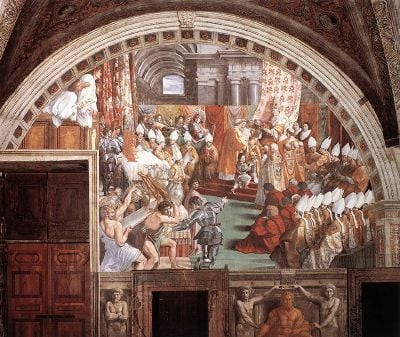
Charlemagne, being a model knight as one of the Nine Worthies, enjoyed an important afterlife in European culture. One of the great medieval literary cycles, the Charlemagne cycle or the Matter of France, centers around the deeds of Charlemagne and his historical commander of the border with Brittany, Roland, and the paladins who are analogous to the knights of the Round Table or King Arthur's court. Their tales constitute the first chansons de geste. Charlemagne is depicted as the champion of Christendom against Muslims and pagans. Charlemagne also dealt diplomatically with Muslims, exchanging ambassadors with Harun al-Rashid and negotiating some degree of responsibility for the welfare of Christians and Christian sites in Palestine.
Charlemagne himself was accorded sainthood inside the Holy Roman Empire after the twelfth century. His canonization by Antipope Paschal III, to gain the favor of Frederick Barbarossa in 1165, was never recognized by the Holy See, which annulled all of Paschal's ordinances at the Third Lateran Council in 1179.
In Dante's Divine Comedy the spirit of Charlemagne appears to Dante in the Heaven of Mars, among the other "warriors of the faith."
It is frequently claimed by genealogists that all people with European ancestry alive today are probably descended from Charlemagne. However, only a small percentage can actually prove descent from him. Charlemagne's marriage and relationship politics and ethics did, however, result in a fairly large number of descendants, all of whom had far better life expectancies than is usually the case for children in that time period. They were married into houses of nobility and as a result of intermarriages many people of noble descent can indeed trace their ancestry back to Charlemagne. He is without a doubt an ancestor of every royal family of Europe.
Charlemagne is memorably quoted by Henry Jones (played by Sean Connery) in the film, Indiana Jones and the Last Crusade. Immediately after using his umbrella to induce a flock of pigeons to smash through the glass cockpit of a pursuing German fighter plane, Henry Jones remarks: "I suddenly remembered my Charlemagne: 'Let my armies be the rocks and the trees and the birds in the sky'."
Family
Marriages and heirs
- His first wife was Himiltrude, married in 766. The marriage was never formally annulled. By her he had:
- Pippin the Hunchback (767 - 813)
- His second wife was Gerperga (often erroneously called Desiderata or Desideria), daughter of Desiderius, king of the Lombards, married in 768, annulled in 771.
- His third wife was Hildegard of Savoy, also known as Hildegard of the Vinzgau (757 or 758 - 783 or 784), married 771, died 784. By her he had:
- Charles the Younger (772 or 773 - 811), king of Neustria from 781
- Adelaide (773 or 774 - 774)
- Carloman, baptized Pippin (773 or 777 - 810), king of Italy from 781
- Rotrude (or Hruodrud) (777 - 810)
- Louis the Pious (778 - 840), twin of Lothair, king of Aquitaine from 781 and Holy Roman Emperor and king of the Franks from 814
- Lothair (778 - 779 or 780), twin of Louis
- Bertha (779 - 823)
- Gisela (781 - 808)
- Hildegarde (782 - 783)
- His fourth wife was Fastrada, married 784, died 794. By her he had:
- Theodrada (b.784), abbess of Argenteuil
- Hiltrude (b.787)
- His fifth and favorite wife was Luitgard, married 794, died 800, childless.
Concubinages and illegitimate children
- His first known concubine was Gersuinda. By her he had:
- Adaltrude (b.774)
- His second known concubine was Madelgard. By her he had:
- Ruodhaid, daughter of Charlemagne (775 - 810), abbess of Faremoutiers
- His third known concubine was Amaltrud of Vienne. By her he had:
- Alpaida (b.794)
- His fourth known concubine was Regina. By her he had:
- Drogo of Metz (801 - 855), bishop of Metz from 823
- Hugh, son of Charlemagne (802 - 844), arch-chancellor of the Empire
- His fifth known concubine was Ethelind. By her he had:
- Theodoric (b.807)
Notes
- ↑ His name in English, Charlemagne, is identical to the French language from, which in turn comes from the Latin. The French translation of Charles the Great is Charles le Grand, which is used. In German, he is called Karl der Große or Karl der Grosse, which means Charles the Great; likewise in Dutch, Karel de Grote. His name in other Romance languages, like Italian and Spanish language Carlomagno, is derived from the Latin. In other Germanic and Slavic languages, it is usually a translation of Charles the Great (Carolus Magnus). Many of the Slavic languages took their word for king from the German name for Charlemagne, Karl: Czech král, South Slavic (such as Slovenian or Serbo-Croatian) kralj, Polish król, etc.
- ↑ Edward Gibbon, The Decline and Fall of the Roman Empire (Everyman's Library, 2010, ISBN 978-0307700766). Indeed, Gibbon regards the kingdoms of France and Germany as preexisting though integrated. It is their separation under the Carolingians that is of historic importance.
- ↑ Charles Oman, The Dark Ages 476–919 (Rivingtons: London, 1914) Regards Charlemagne's grandsons as the first kings of France and Germany, which at the time comprised the whole of the Carolingian Empire save Italy.
- ↑ Einhard, The Life of Charlemagne 22. Personal Appearance The Medieval Sourcebook. Retrieved December 16, 2021.
- ↑ Einhard, The Life of Charlemagne: 4. Plan of This Work The Medieval Sourcebook. Retrieved December 16, 2021.
- ↑ Einhard, The Life of Charlemagne: 7. Saxon War The Medieval Sourcebook. Retrieved December 16, 2021.
- ↑ Song of Roland Internet Medieval Sourcebook. Retrieved December 16, 2021.
- ↑ Einhard, The Life of Charlemagne: 28. Charlemagne Crowned Emperor The Medieval Sourcebook. Retrieved December 16, 2021.
- ↑ Einhard, The Life of Charlemagne: 30. Coronation of Louis - Charlemagne's Death The Medieval Sourcebook. Retrieved December 16, 2021.
- ↑ Roger Collins, Charlemagne (Toronto: University of Toronto Press, 1998, ISBN 0802082181), 147.
- ↑ Collins 1998, 151.
- ↑ Collins 1998, 149.
- ↑ 13.0 13.1 John Julius Norwich, Byzantium: The Early Centuries (New York: Knopf, 1989, ISBN 0394537785), 378.
- ↑ Henri Pirenne, Mohammed and Charlemagne (Mineola, NY: Dover Publications, 2001, ISBN 0486420116), 234.
- ↑ John Julius Norwich, Byzantium: The Apogee ( Knopf, 1992, ISBN 978-0394537795), 3
- ↑ Collins 1998, 151.
- ↑ Pirenne, 233.
- ↑ Collins, 153.
- ↑ Paul Halsall, The Donation of Constantine (c.750-800) The Medieval Sourcebook. Retrieved December 16, 2021.
ReferencesISBN links support NWE through referral fees
- Barbero, Alessandro. Charlemagne, father of a continent Berkeley, CA: University of California Press, 2004. ISBN 0520239431
- Becher, Matthias. Charlemagne trans, David S. Bachrach. New Haven, CT: Yale University Press, 2003. ISBN 0300097964
- Collins, Roger. Charlemagne. Toronto: University of Toronto Press, 1998. ISBN 0802082181
- Collins, Roger. Early Medieval Europe, 300-1000, Second Edition (Palgrave History of Europe) Palgrave Macmillan, 1999. ISBN 0312218869
- Einhard. The Life of Charlemagne translated by Samuel Epes Turner, (New York: Harper & Brothers, 1880). Medieval Sourcebook. Retrieved December 16, 2021.
- Ganshof, François Louis. The Carolingians and the Frankish Monarchy trans. Janet Sondheimer. London: Longman, 1971. ISBN 0582482275
- Gibbon, Edward. The Decline and Fall of the Roman Empire. Everyman's Library, 2010. ISBN 978-0307700766
- Langston, Aileen Lewers, and Buck Jr. Pedigrees of Some of the Emperor Charlemagne's Descendants. Genealogical Publishing Company, 2002. ISBN 0806311630
- Norwich, John Julius. Byzantium - The Apogee. Knopf, 1992. ISBN 978-0394537795
- Norwich, John Julius. Byzantium: The Early Centuries. New York: Knopf, (1st American edition) 1989. ISBN 0394537785
- Oman, Charles. The Dark Ages 476-918. 2017. ISBN 1973427370
- Painter, Sidney. A History of the Middle Ages 284-1500. New York: Knopf, 1967.
- Pirenne, Henri. Mohammed and Charlemagne. Mineola, NY: Dover Publications, 2001. ISBN 0486420116
- Santosuosso, Antonio. Barbarians, Marauders, and Infidels: The Ways of Medieval Warfare. Boulder, CO: Westview Press, 2004. ISBN 0813391539
- Scholz, Bernhard Walter. Carolingian Chronicles: Royal Frankish Annals and Nithard's Histories. Ann Arbor, MI: University of Michigan Press, 1970. ISBN 0472087908
External links
All links retrieved December 3, 2023.
- Vita Karoli Magni (in Latin) by Einhard, The Latin Library.
- Marco Bakker —Reportret: A reconstructed portrait of Charlemagne, based on historical sources, in a contemporary style.
Credits
New World Encyclopedia writers and editors rewrote and completed the Wikipedia article in accordance with New World Encyclopedia standards. This article abides by terms of the Creative Commons CC-by-sa 3.0 License (CC-by-sa), which may be used and disseminated with proper attribution. Credit is due under the terms of this license that can reference both the New World Encyclopedia contributors and the selfless volunteer contributors of the Wikimedia Foundation. To cite this article click here for a list of acceptable citing formats.The history of earlier contributions by wikipedians is accessible to researchers here:
The history of this article since it was imported to New World Encyclopedia:
Note: Some restrictions may apply to use of individual images which are separately licensed.
